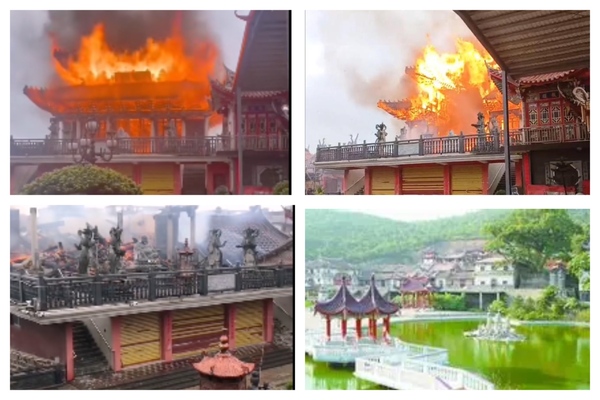On September 22, a fire broke out at Lingyun Palace on Hugong Mountain in Putian, Fujian Province, destroying the building and leaving only a few pillars and statues inside. According to public records, Lingyun Palace, originally named “Lingyun Rock Hermitage,” had thirty-six caves and eighteen courtyards.
Videos circulating online show a temple-like building engulfed in flames, with the fire completely engulfing the structure, leaving only the main frame standing after being burned down. Another video shows that after the fire was extinguished, only a few pillars and statues inside the building remained, with thick smoke still lingering at the scene.
According to the New Beijing News, the burned building is Lingyun Palace, as confirmed by the government in Xindu Town, Putian, Fujian.
Local officials from Puban Village, where Lingyun Palace is located, revealed that the fire at Lingyun Palace started around 11 a.m. Villagers assisted the fire department in extinguishing the fire, which was exacerbated by the rainy weather at the time. The official stated, “The fire was intense, causing significant damage to the wooden structures. The cause of the fire is still unknown.”
Lingyun Palace, dedicated to the Jade Emperor, is situated on the southern slope of Hugong Mountain in Putian, Fujian Province, and is considered a sacred site of Taoism in the region.
The main hall of Lingyun Palace is a two-story structure with intricate carvings on the beams and pillars, featuring a pair of coiled dragon stone pillars under the front eaves. Behind the main hall is the Douzhaoting Palace, flanked by the Bell and Drum Towers, and further back is the Daxiong Baodian. Other notable structures include the Yuyu Bridge and the Seven-Treasure Pagoda. The entire architectural complex is built into the mountain, rising layer by layer, presenting a magnificent sight. There is also a thousand-year-old ancient camphor tree on the left side of the complex.
Lingyun Palace was founded by the Zheng family ancestors of Puban Village and continues to house ancestral worship ceremonies within its premises. Initially known as Lingyun Rock Hermitage in the Song Dynasty, Lingyun Palace was established in the early Ming Dynasty and renamed Lingyun Palace in the sixth year of the Jiajing reign (1527) in the Ming Dynasty. It underwent multiple reconstructions and expansions up to 1948 during the Qing Dynasty. Damaged and abandoned during the Cultural Revolution in the 1960s, it was gradually restored from 1980, retaining its Qing Dynasty architectural features to this day.

